{haunted by 13 Cats, an anxiety Possum, and a bunch of critters in a trenchcoat}
Don't wanna be here? Send us removal request.
Text
In other news
I disappeared from tumblr for eons, mainly because I've been working on both Blackbirds sites. One is a social media site running on the humhub framework called blackbirds.rest and the other is blackbirds.wiki where I plan on continuing the work from tweedle's trove. I still plan on coming back here from time to time as I intend to crosspost stuff to spread it out as much as possible. So that's currently what's been going on in the background.
0 notes
Text




Some images that have been uploaded to blackbirds.wiki where I host the updated version of the marp links and have been doing work to make infographics utilizing the scrubbed and erased CDC info. Have fun spreading these around so that the censorship backfires.
#CDC scrubbed info#LGBTQ+#LGBTQIA+#Transgender#infographics#LGBTQIA#censorship#statistics#cdc guidelines
0 notes
Text
Part 14 of A Treatise of Embroidery, crochet, and knitting with illustrations
By George C. Perkins, Anna Grayson Ford, and M. Heminway & Sons Silk co circa 1899
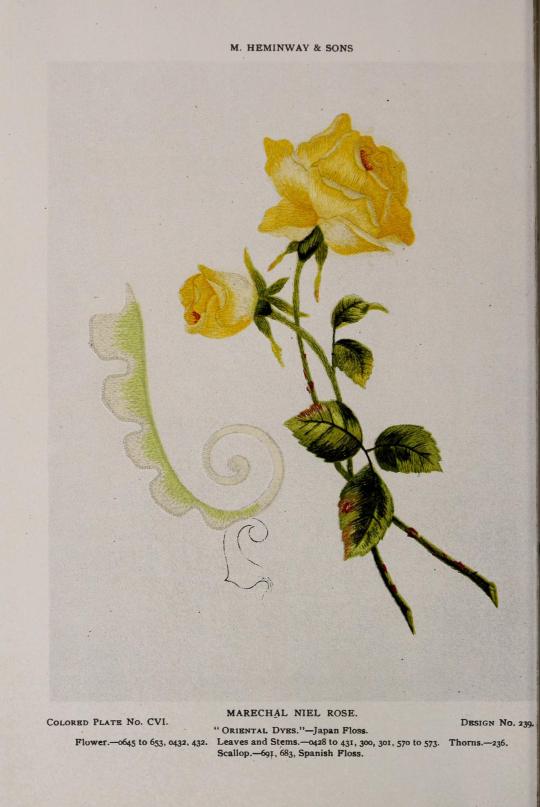
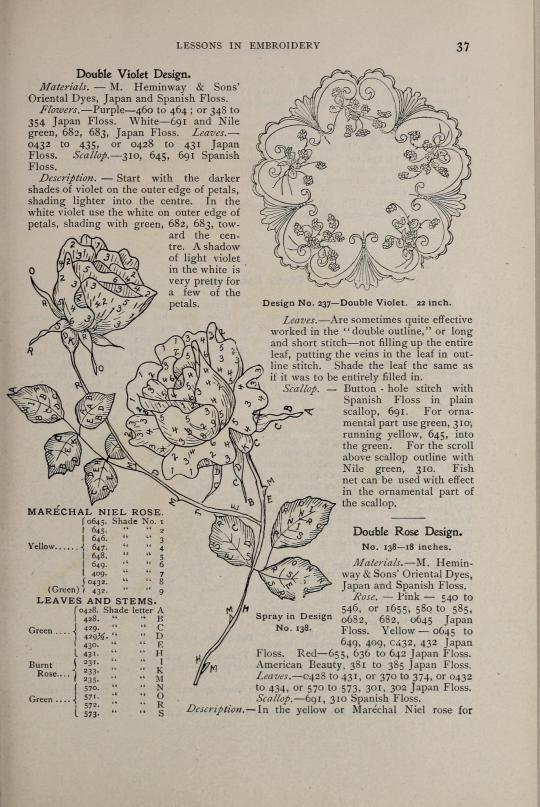
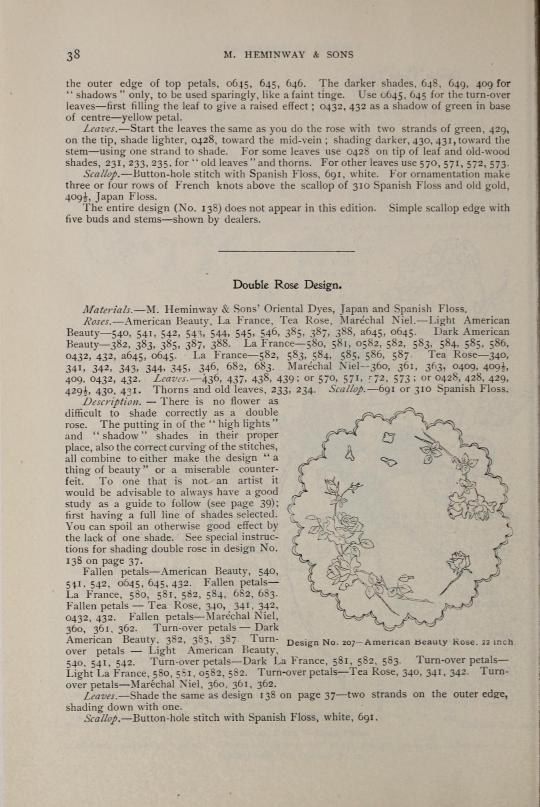
Please note, this book was written in 1899, and as such uses a racist term to refer to the dyes that were used for the thread. If you'd like to read more about this period in time, the term, and the stereotypes that the Victorians had, I've actually linked the wikipedia article here that goes more in depth. It's not the end all be all of it, but it's a good starting place for anyone wanting to educate themselves on the topic.
An indepth description of the diagram is as follows:
The rose stem starts off angled diagonally to the right and is done in H with a pair of thorns, one on either side along the way, done in M. There are three rose leaves in a cluster that have a football sort of shape with squiggly edges. Starting from the base of the leaf and moving in rows to the tip:
Leaf 1 (Leftmost Leaf): S, E D, S C, R(tip).
Leaf 2 (Topmost leaf): R, R N I S, O N R O, I, N(tip).
Leaf 3 (Rightmost Leaf): R S, O S E R, N (illegible but possibly R) O, N(tip).
Moving along the stem upwards beyond the leaves we hit the fork leading off to the second rose, however continuing up the rightmost past leads to the first, larger, and more fully bloomed rose.
The stem connecting to the larger rose on the right is done in E with another thorn done in M. There are three sepals emerging from the rose. Left to right their colouration is as follows:
Left Sepal: D, C.
Center Sepal: D, C, B.
Right Sepal: C, B, A.
There is a small section they adjoin that the underside of the rose is visible and done in K.
The rose itself is yellow and starting on the left of the bottom center petal that is almost the width of the blossom and moving upwards in rows towards the center of the bloom:
Petal 1,Row 1. Each of these numbers has a divot in the petal between them forming a scalloped edge:
1, 3(the petal has flipped to reveal it's underside), 3 (the petal has turned back to normal, there is a gap here due to a scallop in the rose petal, 4, 5 (underside), 4(topside), 3 (underside), 3 (topside).
Row 2: 3, 2, 4, here is a continuation of the gap from the previous petal that has shrunken slightly and terminates in a v shaped point in the next row, 3.
Row 3: 2, 4, 6, V point, 5, 4.
Moving clockwise to the next outer petal which is about half the size of the previous one and curves slightly upwards so the rows are now columns:
Petal 2, Column 1: 3, 2 (underside), 3 (topside), 3, 4.
Column 2: 3, 4.
Petal 3, column 1: 1, 1. Column 2: 2, 2.
Column 3, peeping out from behind the largest front facing center petals edge: 3.
Petal 4, row 1: 1, 1. row 2: 2.
Petal 5, row 1: 3, 4. Row 2: 6.
Petal 6, is the last petal for the outer ring and butts up against Petal 1 on the right side. Column 1: 3.
Column 2: 2 (underside), 5(topside), 3, 4.
Column 3: 2, 3, 4, 5.
The inner petals are all held in by two larger petals, the left overlapping the right like a jacket.
Both have the petal lip turned over much like a jacket colar as well, and it's done in 1's.
Left Petal Inner, done in rows from bottom to top. Row 1:
3, 8, 1.
Row 2: 4, 3, 2, 9.
Row 3: 5, 5, 3.
Row 4 is the petal lip on a diagonal slant.
Right Petal Inner, Row 1: 6.
Row 2: 5.
Row 3: 4, 2.
Row 4: 3, 4.
Row 5: 4.
Row 6 is the petal lip also on a diagonal slant but smaller than the left one.
The last 4 petals are arranged with one in the center v of the outer petal "jacket" and the other 3 fanning out behind it.
Starting with bottom petal and working clockwise in rows from bottom to top. Row 1: 6.
Row 2: 5.
Row 3:
4 (topside), 2 (underside), 4 (topside).
Petal 2, Column 1:
3, 5.
Petal 3, Column 1: 4.
Column 2: 3, 6.
Petal 4 is done entirely in 5.
Back down to the fork of the stem, the leftmost fork is done in E that transitions to d with two thorns done in M.
This stem also forks at the top, but the left fork is a set of 5 leaves. There is one on either side that form a matched pair, and then a second matched pair above that, and the stem terminates with a single leaf emerging from the tip.
The Leaves will be in pairs from left to right, from the bottom of the stem to the tip.
Pair 1, Left Leaf:
Tip is done in C, and then gradients to D, then E, and ends in a touch of H on one side of the leaf at the base.
The Right leaf goes under the stem leading up to the smaller rose and has no lettering, so you can pick one of the colours you used from the other leaf to make it match.
Pair 2, Left leaf.
Tip is done in I, then B, Then splits along the center into two different colours, A for the one side and D for the other, before going back to E, and then splitting again into C and K.
Pair 2, Right Leaf. There is no letter at the tip, instead the leaf is split with the top going from B to A, tip end to base, and the bottom going, D, B, E respectively.
The Top Leaf Goes from A at the tip, to I and B, then to B at the left edge and C, before ending at D at the base.
The stem for the rose passes under Pair 2 Right Leaf and is done in R. With 4 sepals, done in O, R, O at the tips, and R, S, R, at their bases respectively from left to right.
The flower bulb base thing is done in D and K. The rose itself has the front petals left, over right, and thenthe rest of the petals emerging in an alternating fanned fishscale sort of arrangement behind bottom center "jacket" V petal once again.
Starting with the outer left petal, Row 1 from the bottom up: 6.
Row 2: 5, 4, 3.
Row 3: 2, 3, 2(underside).
Row 4: 2.
Outer right petal, row 1: 4, 3.
Row 2: 4, 1, 1.
Row 3: 2, 3.
Row 4: 3, 5.
Row 5: 3(underside), 4(topside), 2.
Center Petal: 5, 1(underside), 6(topside).
Above that is the row of outer petals, the left done in 4 and 3 at the base with 2 at the tip, the center done in 3, and the right done in 4 at the base with 2 at the tip.
Behind them are two other petals in the gaps between the layer in front of them and they are both done in 1.
#embroidery#embroidery pattern#historical sewing#historical embroidery#victorian embroidery#victorian#needlework
11 notes
·
View notes
Text
On Museums and their Links
While I believe it's important to have access to educational resources and that the digitized collections of museums are an amazing educational resource that the public has access to, we must acknowledge that much of that knowledge comes from great injustices, stolen artifacts, and stolen people. According to ProPublica: "Three decades after legislation pushed for the return of Native American remains to Indigenous communities, many of the nation’s top museums and universities still have the remains of thousands of people in their collections.
The University of California, Berkeley still has the remains of at least 4,900 Native Americans that it has not made available for return. Harvard University still has the remains of at least 5,600 Native Americans.The American Museum of Natural History still has the remains of at least 1,800 Native Americans.The Department of the Interior still has the remains of at least 3,600 Native Americans." And these stats are ONLY for human remains. We haven't even touched on the stolen cultural artifacts.
For example, currently The Tlingit and Haida Tribes from Alaska have been dealing with the Denver Art Museum refusing to repatriate artifacts even after being requested to multiple times. This is apparently not the only time the Denver Art Museum has done this either, as they have a regular habit of refusing to be transparent about cultural they have that are stolen and whether or not they have been repatriated So I am planning on going through and tagging the museums in my resource list that are still holding on to the bodies of people, as well as cultural artifacts, and have not released them back, with a note of "Have Unrepatriated Human Remains and/or Artifacts." I think it's more important to, rather than remove the museums from the list and ensuring people remain unawares, instead let you know exactly which museums still are holding on to the bodies and cultural artifacts of various tribes. This way, the issue cannot be swept under the rug, you can make your voice heard, and together we can pressure said institutions to follow NAGPRA, and ensure that they are held accountable for their actions. Educational institutions and Museums must do outreach and work with the affected tribes and communities to return their people and artifacts, allow said tribes to make decisions about whether or not they wish certain things, such as to allow copies to be kept by the museum or displayed, and create socially conscious and truly historically accurate exhibits. This is the bare minimum tbh of what they should be doing. I think it's also important to understand this, While yes, refusing to give museums money if they refuse to repatriate is a great course of action (please do), accessing the free resource materials to broaden your education from these institutions is not a bad thing, and doesn't make you bad either. Learning is what lead you here, and it will lead you to more places if you keep going. We cannot rectify what is unknown to us or has been purposely hidden, so we must call for transparency, and always seek the truth. With more people looking into said collections and institutions, we can rectify past wrongs, ensure we find historical inaccuracies and inconsistencies due to whitewashing, erasure, and supremacist rhetoric, and boost the voices of people who are being ignored so they can share their histories, and tell the stories that never get told. So as always, stay curious, be kind, seek the truth, and always support and protect each other. The world will be better because of it.
0 notes
Text
This man is getting close to reaching his goal to get his family out of Gaza
This man is really close to reaching his goal to evacuate his family from Rafah, but recently he lost contact with them and then found out that his family had been bombed and his mother and sister were injured. Source is his latest video from 2 days ago:
He's already lost his father and their house was destroyed. The crossing fees for his family to get into Egypt are super expensive and now with being unsure who else in his family is injured or may have been killed, he really needs help.
#free palestine#gaza#all eyes on rafah#palestine fundraiser#palestine#gofundme#fundraising#donate if you can
6 notes
·
View notes
Text
youtube
this is a machine that was used to punch the cards for the jacquard looms circa the 1800s! Below, there's a demonstration of this technology in action:
youtube
#weaving#punch card looms#weaving technology#history#educational content#old technology#analog technology#Youtube
2 notes
·
View notes
Text
youtube
An amazing documentary on an older bit of computer technology that uses punchcards. What makes this more amazing too, is that this is a VERY old form of programming that dates back to the 1700s. Before we had these types of electric punchcard computers, Paper punchcards were used to make weaving patterns for things like dobbies when making jacquard fabric and lace patterns for big looms, automatons, and in a lot of ways works like the drum on a music box. It's a way to have mechanical programming instead of coding electronics. Electronics are smaller, load faster, and can hold much much more data, but Punch card equipment has it's own benefits as well. I'm actually old enough and fortunate enough to have handled old punch card and mag striped equipment when helping my mom in her classroom, it was a very outdated tech then. But it's not just charming, fun to use, and fairly simple to pickup, it's practical, and at least for me I can understand it better than I can with coding now due to my issues with losing my memory. Honestly it's a fascinating rabbithole to go down, because it leads you to analog technology and how simple it really is. From the fact that a speaker is just something that can vibrate a pattern like a piece of cardboard or rubber attached to a needle being cranked over a record like this:
youtube
You'd be surprised what you can do mechanically. And a solid mechanical build combined with simple electronics like an arduino if you're able to learn can make amazing things.
#mechanics#punch card computers#punch cards#old technology#amazing things#learn something new#gramophone#Youtube
5 notes
·
View notes
Text
list of GFMs for families trying to evacuate gaza
making a list of all of the fundraisers of people who have reached out to me directly on here in order to have them all in one place. all of them have either been vetted by other users or i verified them personally by checking their other social media accounts (like twitter or instagram) to confirm. everyone here definitely needs support, a lot of their family members are injured or in need of medical care that is not available in gaza. i am also linking their tumblr accounts so that you can follow them to keep up with their campaigns.
Ezzideen Shehab - his tumblr was banned but his close friend and campaign runner is @boshradaoud - €15,489/32,500
Haya Orouq - @haya-orouq19 - $45,400/55,000 (USD)
Nesma Ahmed - @nesmaah - $12,056/45,000 (USD)
Hala - @hlabarka22 - $3,677/50,000 (CAD)
Sahar El Tibi - @eltibisahar - €2,020/30,000
Haneen Atya Altalla - @haneenatya - $23,555/70,000 (AUD)
Sujood Odeh - @sujoododeh - £20,818/50,000
Fatma Bassem - @fatmabassem - $16,139/40,000 (USD)
Donia Tanani - @doniatanani - €67,973/100,000
Nozha Emad - (Donia's sister) - €1,644/18,000
Said Tanani - (Donia's brother) - €31,575/50,000
Abdullah Haniya - @amhdes90 - $2,704/47,000 (USD)
Amal Abushaban - @amalabushaban - €5,510/50,000
10K notes
·
View notes
Text
Help Evacuate A Family From Gaza
This is a fundraiser organized by Dalia Mabad in order to evacuate 18 of her family members from Gaza, many of them children.
She posted a small update recently on the bombing happening in Rafah and the photos left me at a loss for words knowing there is nowhere else for people to go and there's so many people trapped there.
She's getting closer to her goal, so please, if you can spare even a dollar or two, please donate.
https://gofund.me/e793e4d3
9 notes
·
View notes
Text
Decided to migrate the Resource Pages from Blackbirds.rest to this blog.
I tend to use this blog more often and I find I enjoy not having quite so limited a scope with stuff I post.
Expect page updates to come rolling in. I plan on taking this opportunity to expand the resource page links and organize them by category on the state pages! Until they're finished updating however, the buttons will redirect back to the blackbird's rest resource pages.
1 note
·
View note
Text
Been running some experiments
with Feather wiki on how to be able to upload pdfs and optimize them along with images and videos for the smallest possible file size. I don't want to sacrifice all the image quality as they are instructional, but I do need to try and pack things in as small as possible so that things don't take eons to load and can fit on a typical usb stick or sd card. So far I've been running tests with two pages from this 1886 book and trying to figure out how to adjust the colours to trim down the file size. Affinity's web safe dither works meh, so I decided on a whim to try this palette shader app by greenf0x I downloaded the other day for free from itch.io. Lo and behold it works amazingly well, shrinking the cover image from 5.27 MB down to 567 kb as a jpg and 693kb as a png file. I've pasted the before and after. I decided to go with black and white because colour requires a different kind of dithering and the app is limited to colours either preconfigured or manually added to a custom palette.



For reference the custom palette is the last one, as you can see it's just a colourized version of the page with dither.
Then came the big question, Text. The text page saved from Archive.org was already really small at 951kb but with the dithering it managed to push it all the way down to a tiny 305kb, and still maintained clarity.
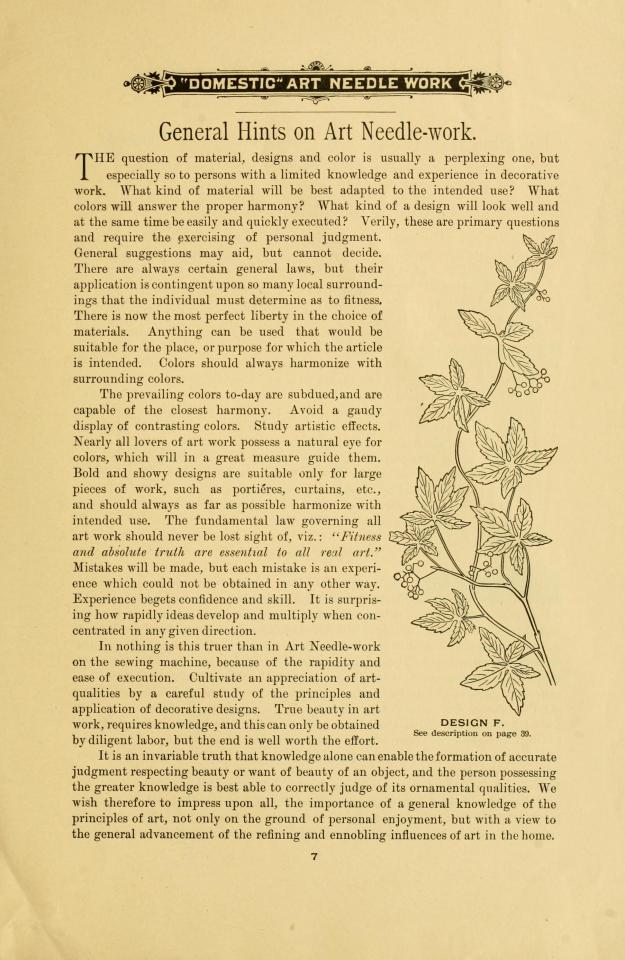
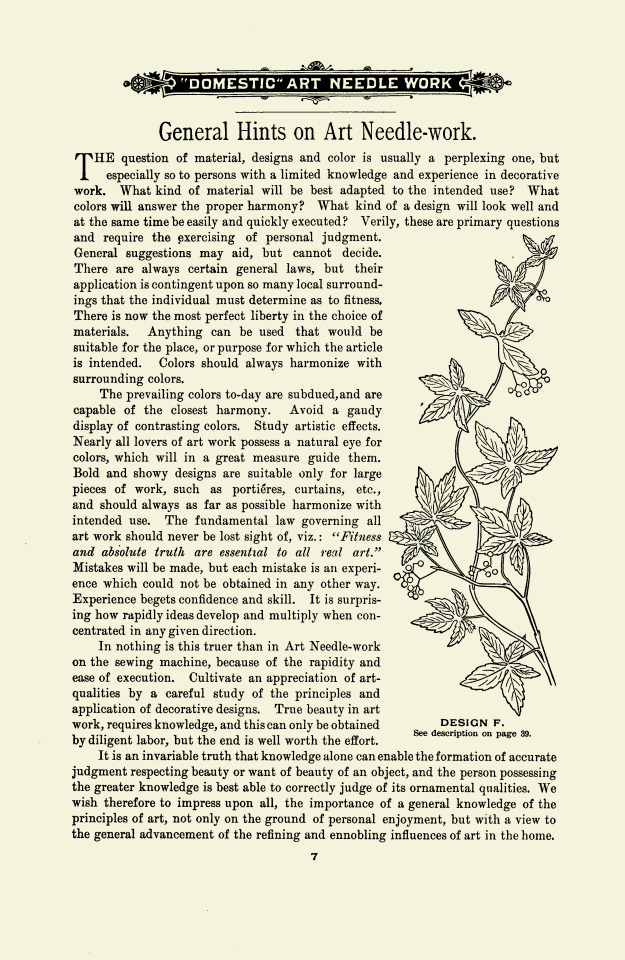
I'm debating how I want to do this as There are times where I don't want to sacrifice colour. I know there's plenty of dithering web apps out there however, but this little gem that I found works amazingly well for the monochrome conversions, so I may wind up seeing if I can't repackage PDFs into tinier versions specifically for the wiki so that it comes with public domain book downloads and links to the colour versions on archive.org. I welcome any suggestions on how to do this, and what readers would likely prefer from a tiny library!
0 notes
Text
Decided to try and swap out the text editor on this for suneditor, like is discussed here on the feather wiki website
it's actually surprisingly easy, following the instructions from the website you just Save the SunEditor extension file that is a small script downloaded off the website to the same folder as your Feather Wiki file and add <script src="./suneditor-replacement.js"></script> to the "Custom Head" text area in Wiki Settings. After that go to the github repo of SunEditor and download the suneditor.min.css and suneditor.min.js codes and put them in the same folder as feather wiki as well.
The hardest part which wasn't terribly hard at all, open up the suneditor-replacement.js script in notepad or notepad++ and go to where it says css.href= and replace the link in quotes with this "suneditor.min.css"
Then go to where it says script.src= and replace the link in quotes with this "suneditor.min.js" the whole lines should look like css.href="suneditor.min.css"; and script.src="suneditor.min.js";
respectively, the punctuation is important and so is the capitalization!!!
after that save the script, make sure the wiki page is saved and reloaded and it should be up and running, but in order to enable video, you'll want to modify one last thing in the script. Look for where it says buttonList in the code, and you'll see a sort of list where it shows the options for the text editor that you want enabled, like ['undo', 'redo'], and so on. you can highlight all the options and replace them with this chunk:
['undo', 'redo'], ['font', 'fontSize', 'formatBlock'], ['paragraphStyle', 'blockquote'], ['bold', 'underline', 'italic', 'strike', 'subscript', 'superscript'], ['fontColor', 'hiliteColor', 'textStyle','lineHeight'], ['removeFormat'], ['outdent', 'indent'], ['align', 'horizontalRule', 'list'], ['table', 'link', 'image', 'video', 'audio'], ['fullScreen', 'showBlocks', 'codeView'], ['preview', 'print'], ['save', 'template'] So the whole thing should look like
buttonList: [ ['undo', 'redo'], ['font', 'fontSize', 'formatBlock'], ['paragraphStyle', 'blockquote'], ['bold', 'underline', 'italic', 'strike', 'subscript', 'superscript'], ['fontColor', 'hiliteColor', 'textStyle','lineHeight'], ['removeFormat'], ['outdent', 'indent'], ['align', 'horizontalRule', 'list'], ['table', 'link', 'image', 'video', 'audio'], ['fullScreen', 'showBlocks', 'codeView'], ['preview', 'print'], ['save', 'template'] ],
Remember, punctuation is important. If anything borks it's likely you accidentally erased a comma or parenthesis. Don't panic. You can always just redownload the vanilla script and try again as there's not a lot to modify in this code. If you've done it correctly however, it should work as soon as you save and reload, so you should be able to embed media like this:
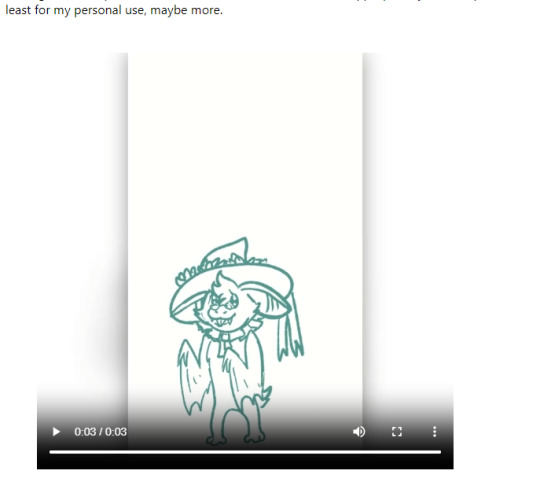
An amazing little personal wiki doodad
Once again trawling itch.io I came across another amazing thing, this time it is a wiki framework called Feather Wiki that loads up and can be edited on your browser, pretty much no more tech skills needed than being able to use tumblr. Here's a test page that I made copying some content from wikipedia to see how it works. The hyperlinks all lead to wikipedia straight from pasting in, but I could easily change it to my own nested pages. It took all of 5 minutes to figure out and get up and running. It's super lightweight and fast as well. I'm planning on using it to put down all the accurate info and stuff I come across on the web so I can at least have something to reference back to for when my memory loss gets worse. My wiki is completely offline and hosted on my desktop. I just click on the shortcut and I can edit, so I do like it a lot, but it can also be hosted on a web server according to the info page.
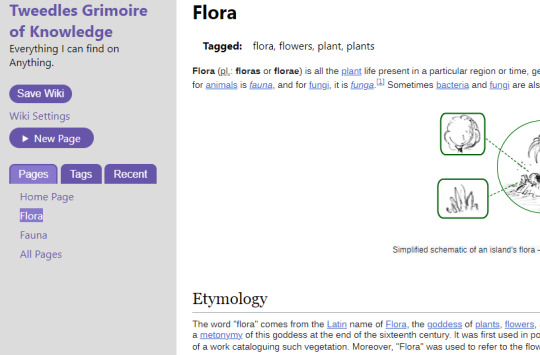
Tbh in an age of disinfo and misinfo, having your own personal wiki where you can log accurate information you find may not be a bad idea. Especially if it's something not only free but simple and easy to run, and useable offline to ensure privacy.
6 notes
·
View notes
Text
An amazing little personal wiki doodad
Once again trawling itch.io I came across another amazing thing, this time it is a wiki framework called Feather Wiki that loads up and can be edited on your browser, pretty much no more tech skills needed than being able to use tumblr. Here's a test page that I made copying some content from wikipedia to see how it works. The hyperlinks all lead to wikipedia straight from pasting in, but I could easily change it to my own nested pages. It took all of 5 minutes to figure out and get up and running. It's super lightweight and fast as well. I'm planning on using it to put down all the accurate info and stuff I come across on the web so I can at least have something to reference back to for when my memory loss gets worse. My wiki is completely offline and hosted on my desktop. I just click on the shortcut and I can edit, so I do like it a lot, but it can also be hosted on a web server according to the info page.

Tbh in an age of disinfo and misinfo, having your own personal wiki where you can log accurate information you find may not be a bad idea. Especially if it's something not only free but simple and easy to run, and useable offline to ensure privacy.
#tweedle's link dumps#tweedle's notebook#tweedle talks#programs#wiki framework#feather wiki#educational content
6 notes
·
View notes
Text
stumbled across an interesting and useful little program today trawling itch.io. its a sort of note taking app with alarm functions to remind you of stuff + mp3 player + a LOT more.
0 notes
Text
Glove Lore
By Otis H. Kean, S. W. Laird, and Buffalo & co. Published in 1897
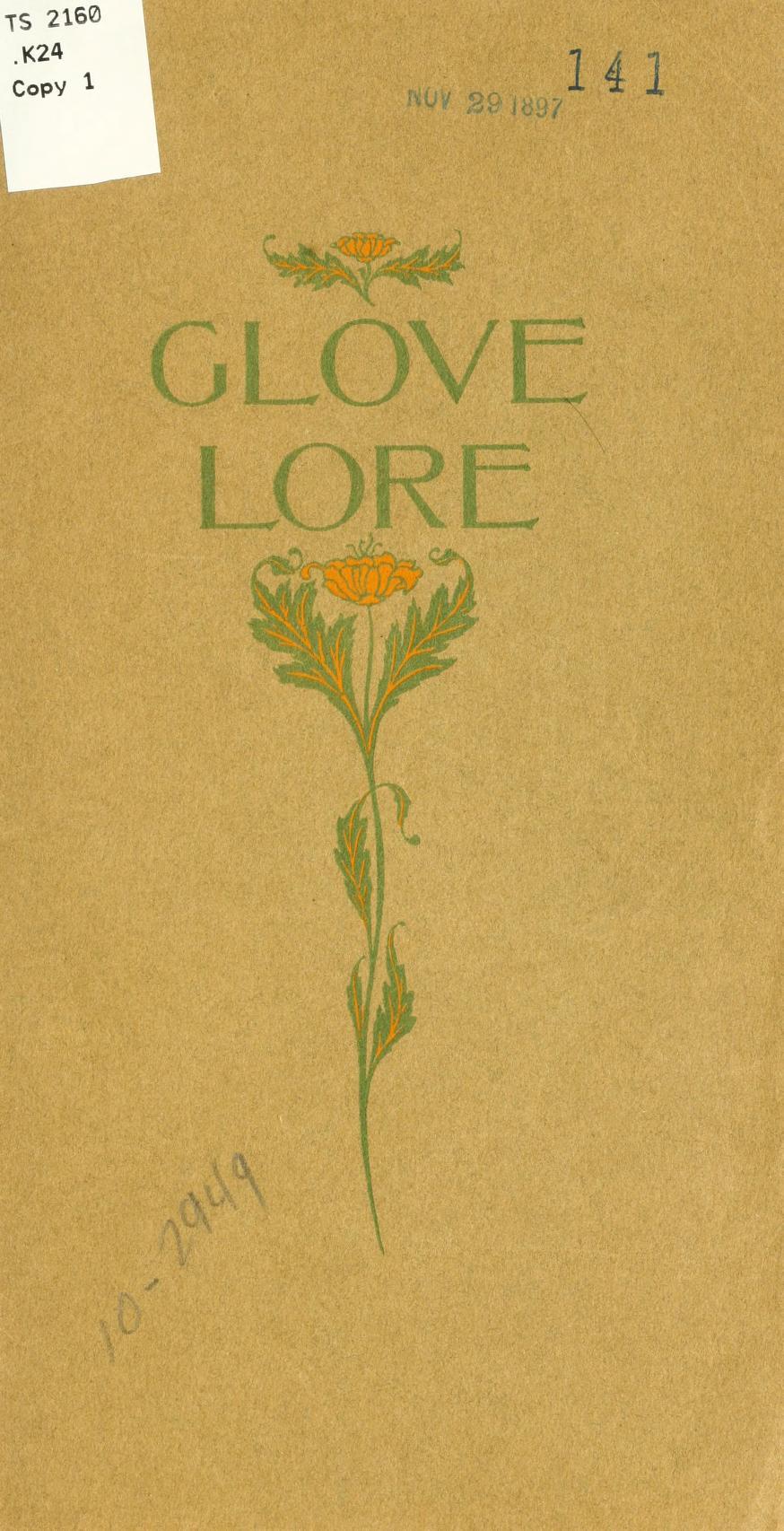
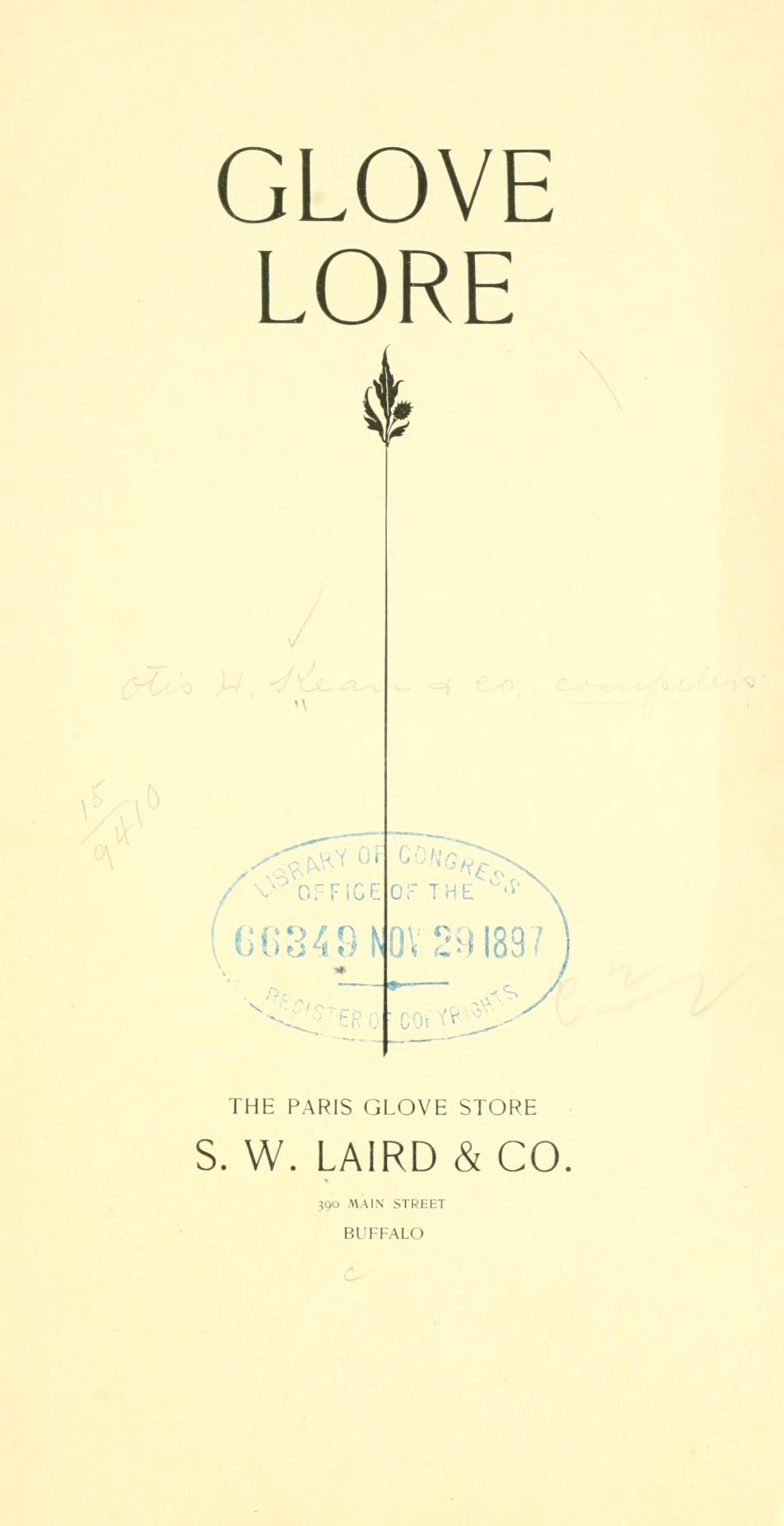
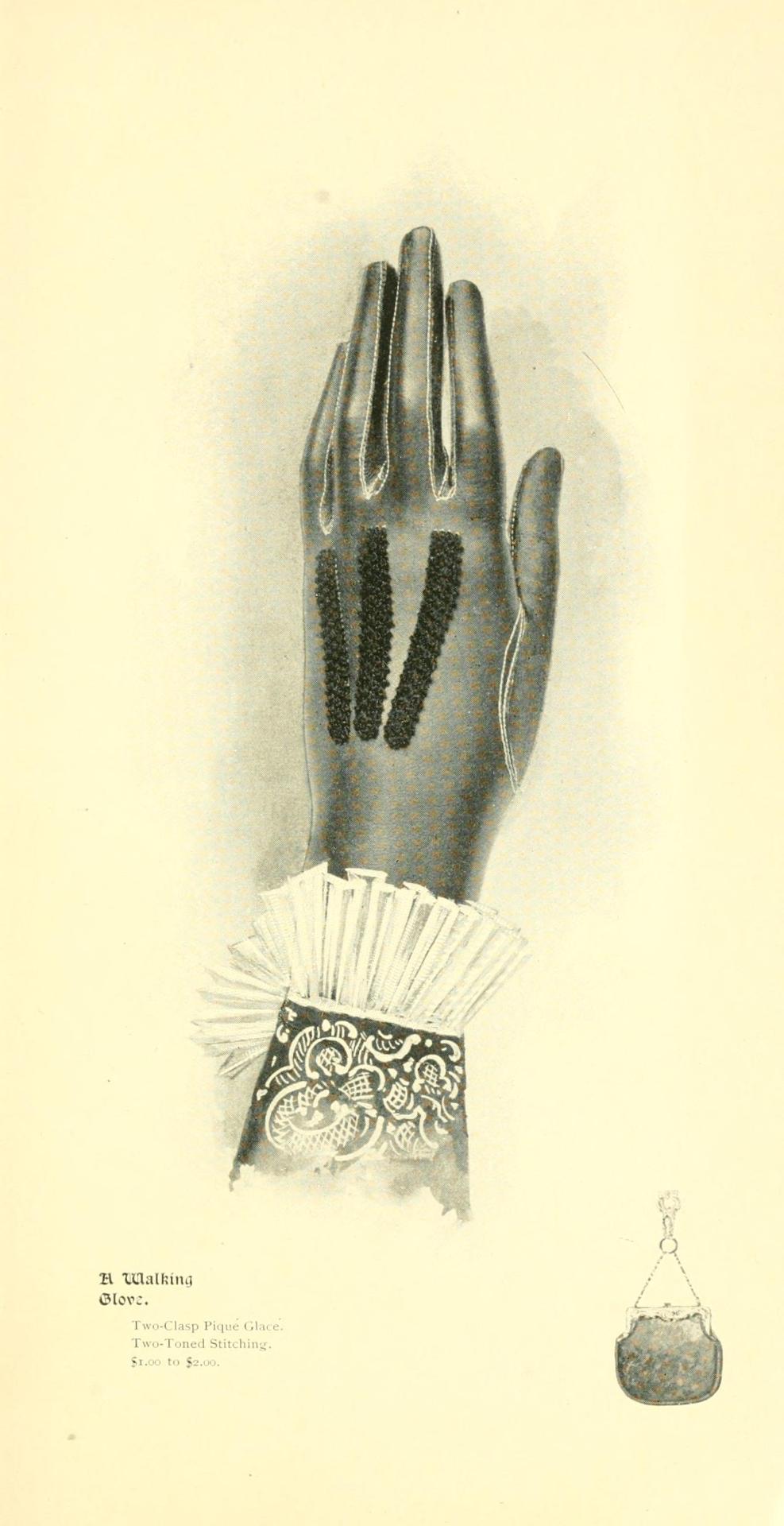
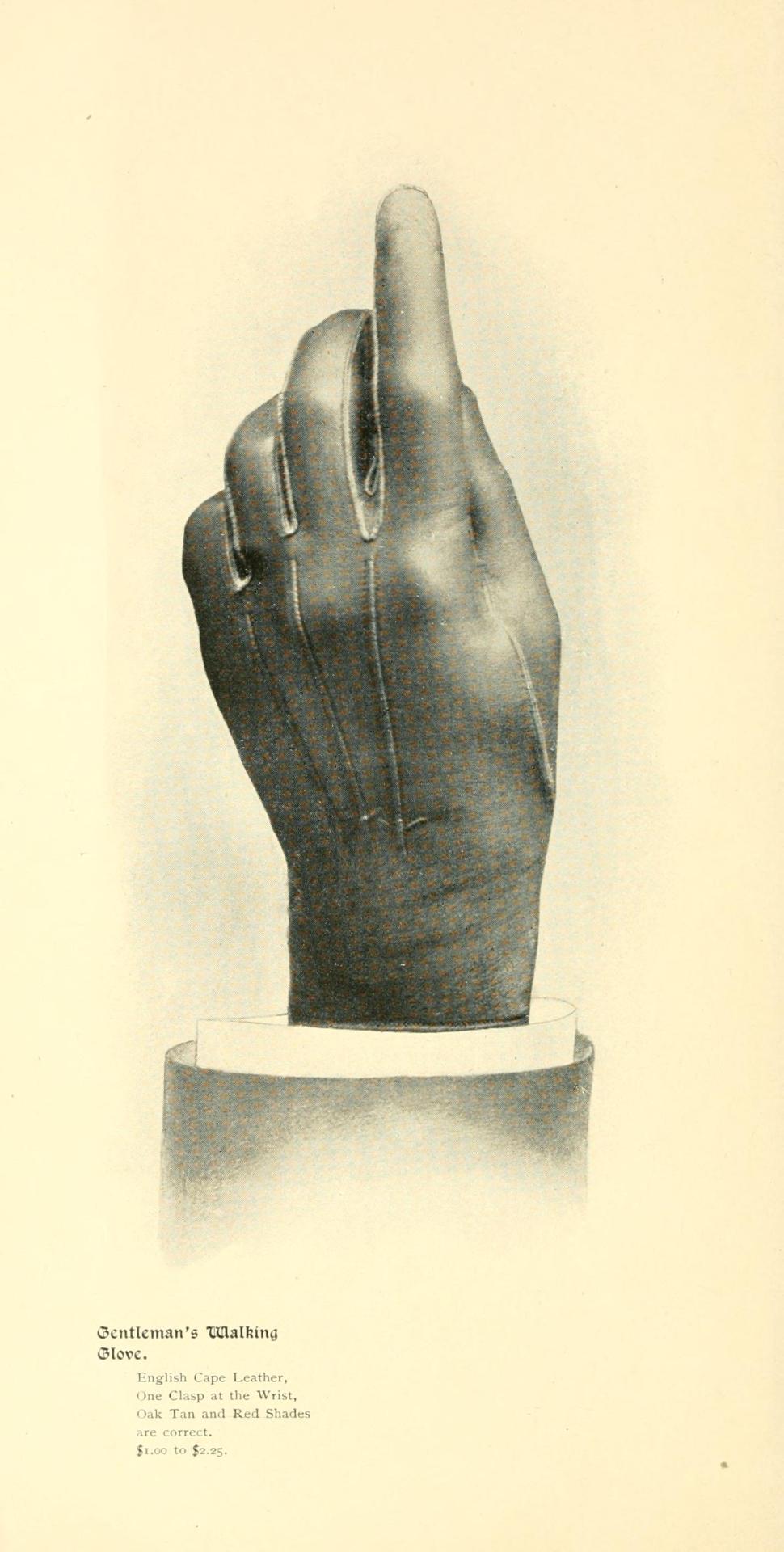
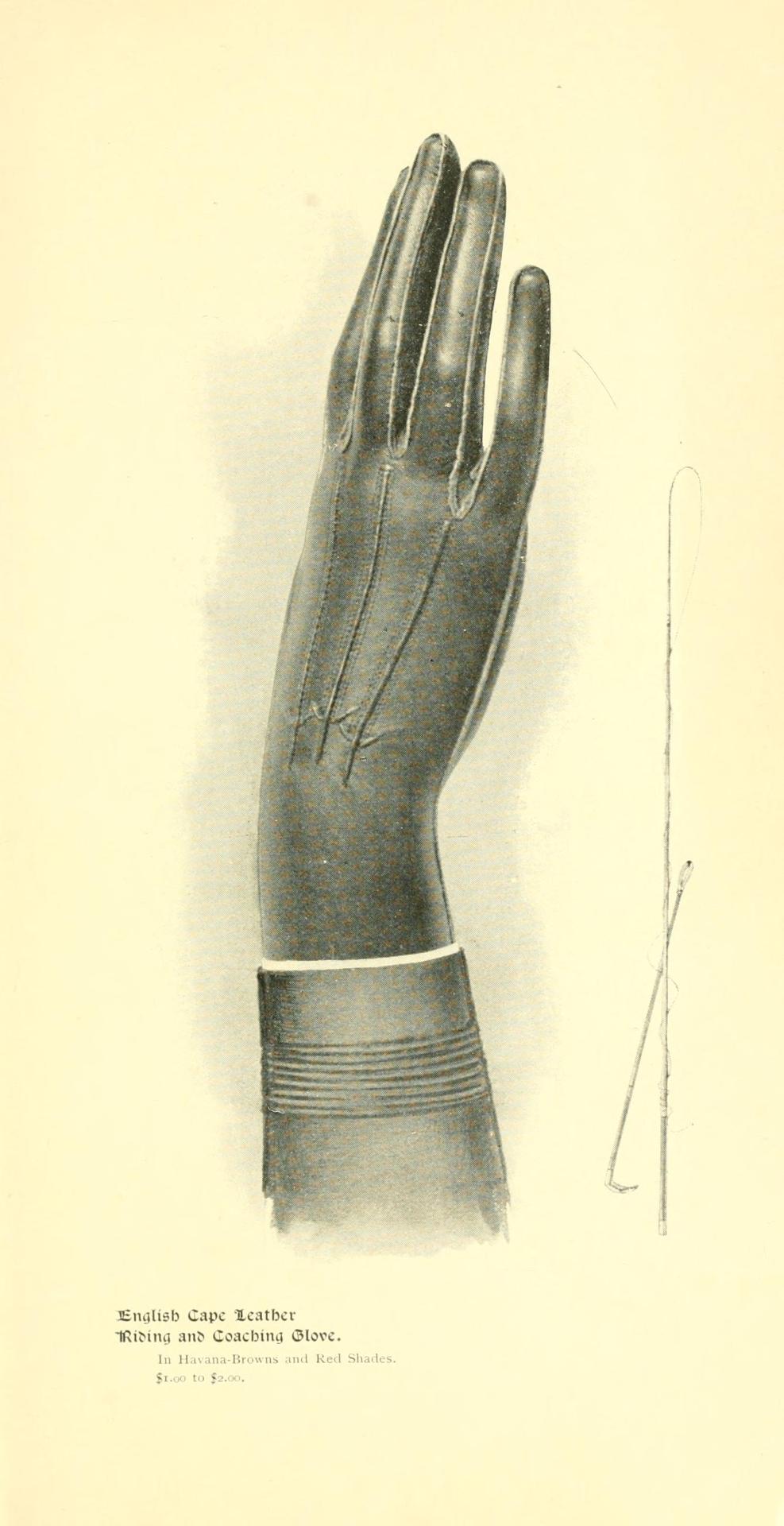
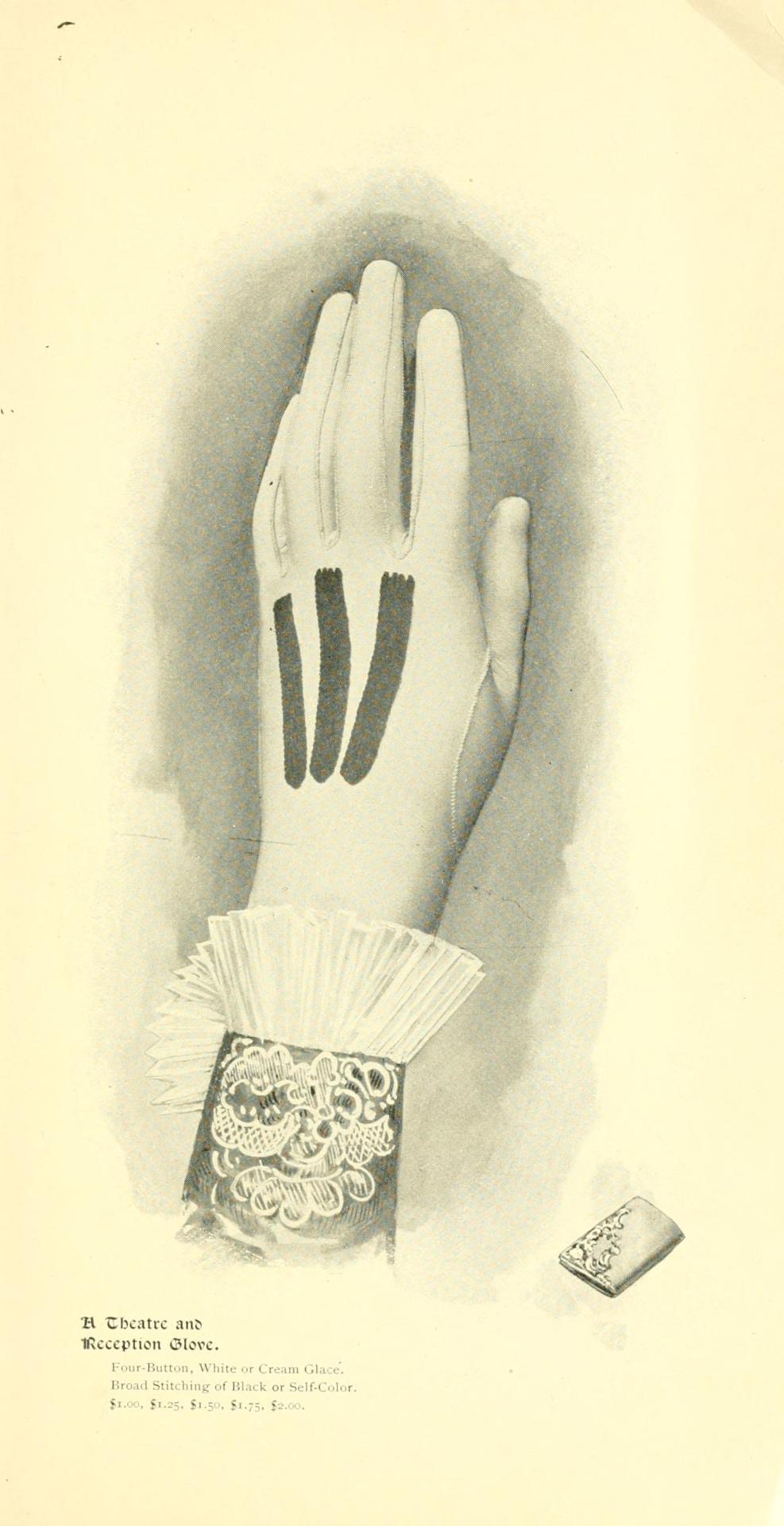

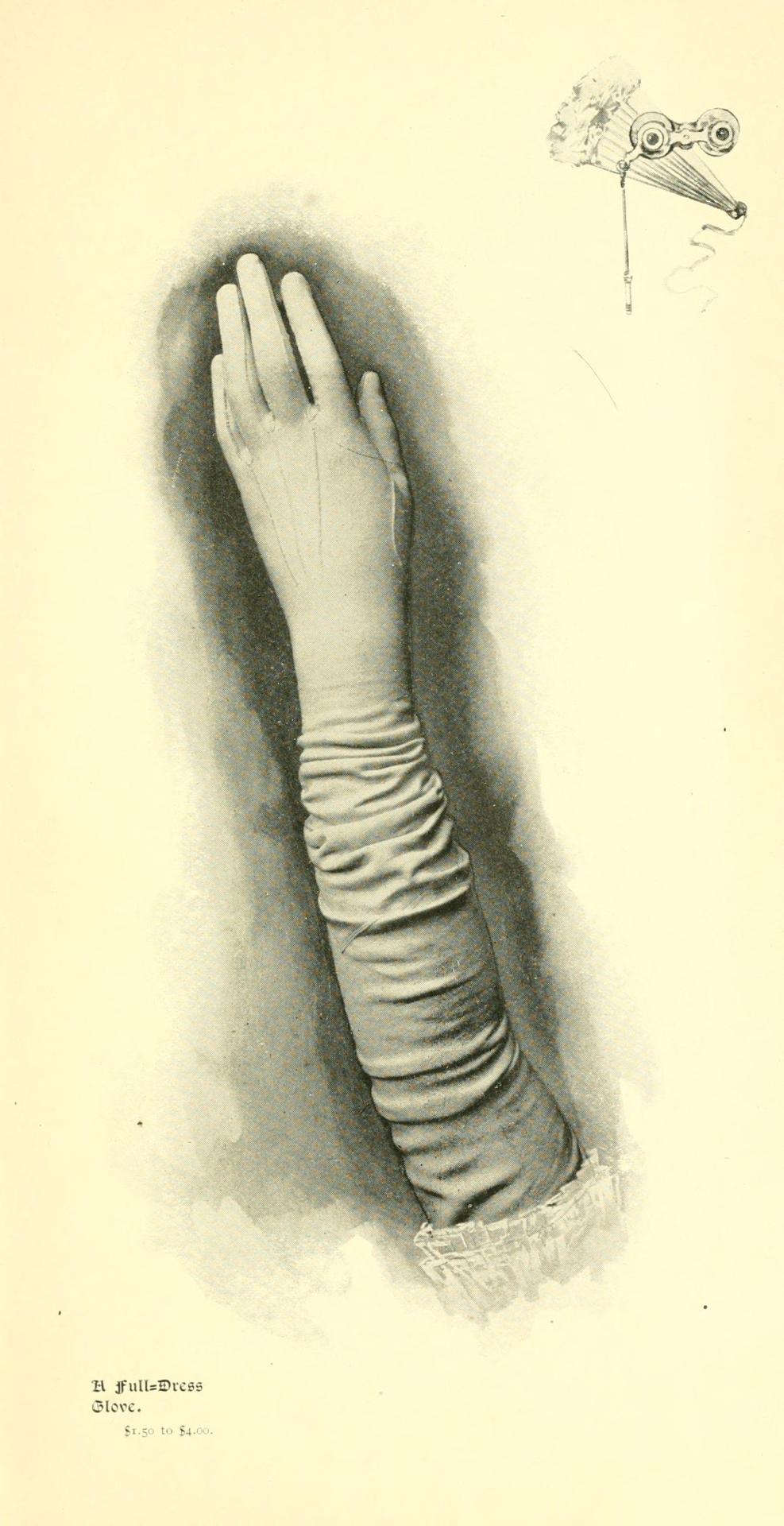
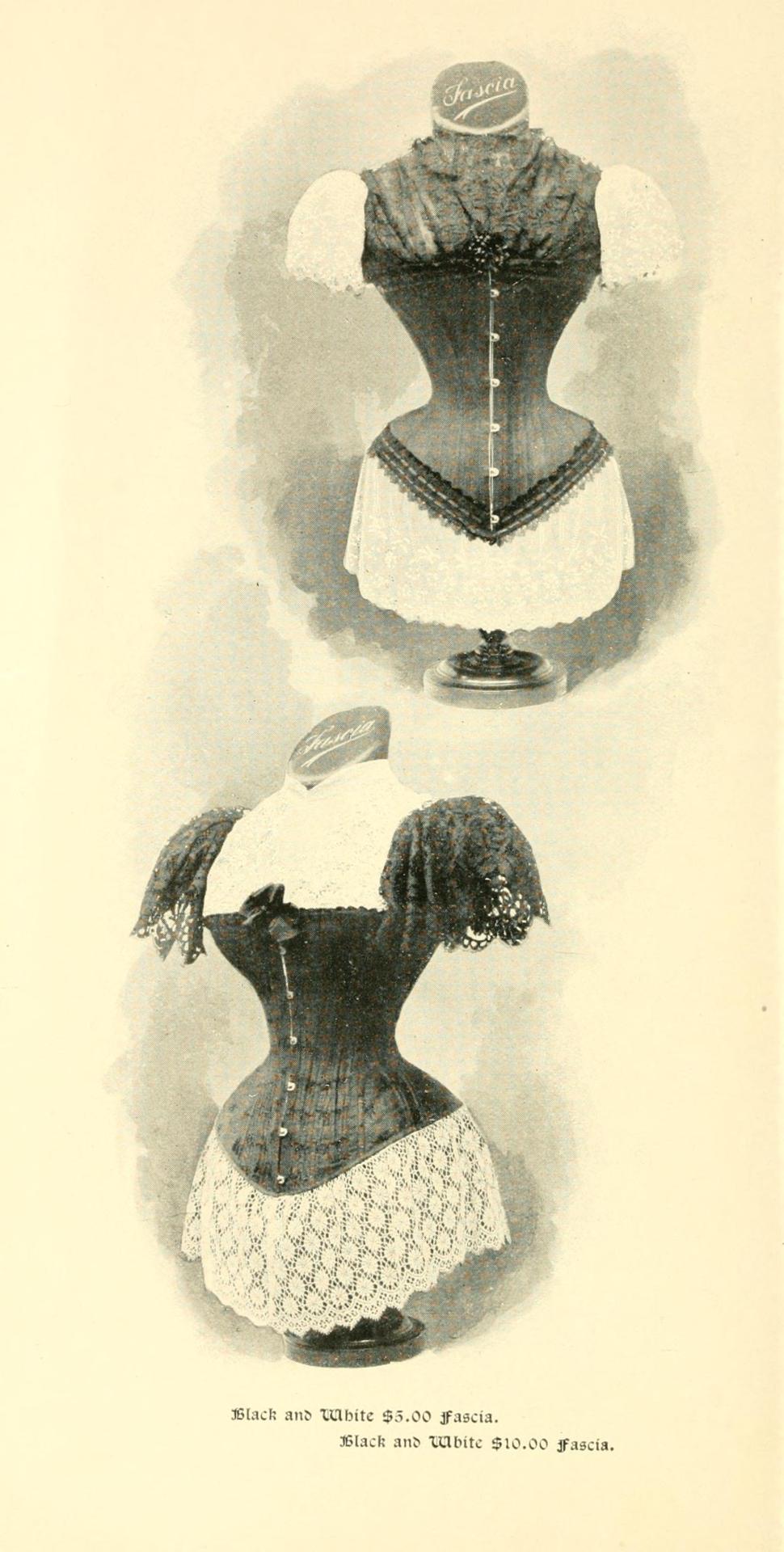

Note: I didn't include all the pages from this book as I'm focused on the clothing illustrations and not the texts this time. However I will be posting links to the topics the texts talk about that are more up to date, as well as related topics if you're interested in that rabbithole. If you wish to read the original, here is a link to the archive.org copy :} The native audio function works well for this particular book.
I did not wish to transcribe all the texts is that it comes from a VERY Western-centric Victorian point of view. So instead I'd like to link to various articles and exhibits with a wider scope that can be found in many of these older books. So here's some more accurate info on Gloves and mittens from Wikipedia and National Geographic, as well as specific information about the customs of perfumed gloves and Episcopal gloves. There is a lot of focus on English Medieval Clothing and an entire article on Evening gloves available on Wikipedia. The book also discusses gauntlets and some historical gloves This book also includes an illustration of Queen Elizabeth the first's Gloves done in watercolour, next to it is a photograph of the same gloves from the Ashmolean Museum in Oxford.
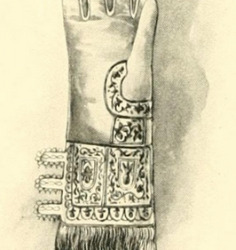
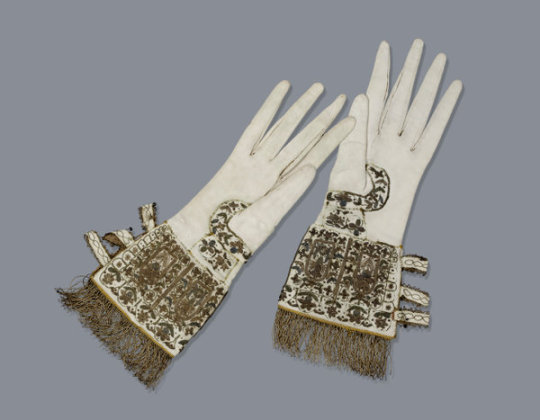
Additional images pulled from some of the pages. There are a few more, but I prefer to focus on the ones with gloves for references.



#victorian#victorian fashion#historical fashion#historical clothing#gloves#1890s#1890s fashion#1897#victorian menswear#victorian womenswear#accessories#historical accessories
20 notes
·
View notes
Text
Part 13 of A Treatise of Embroidery, crochet, and knitting with illustrations
By George C. Perkins, Anna Grayson Ford, and M. Heminway & Sons Silk co circa 1899
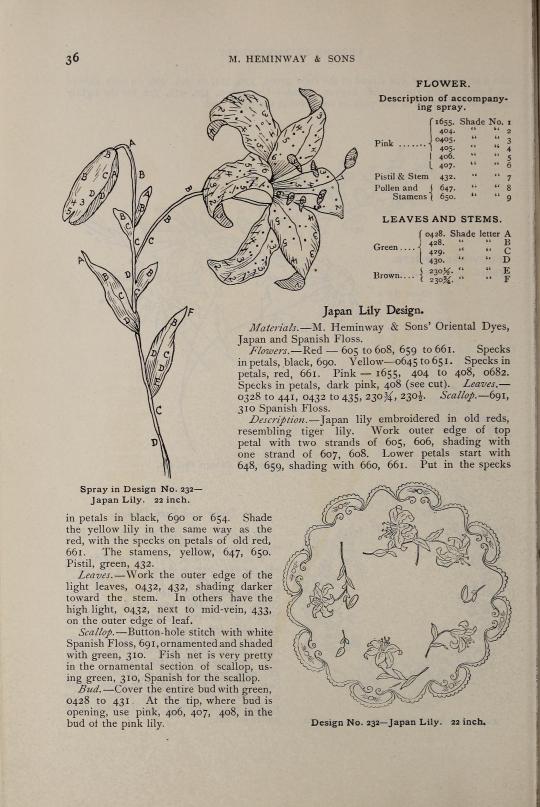
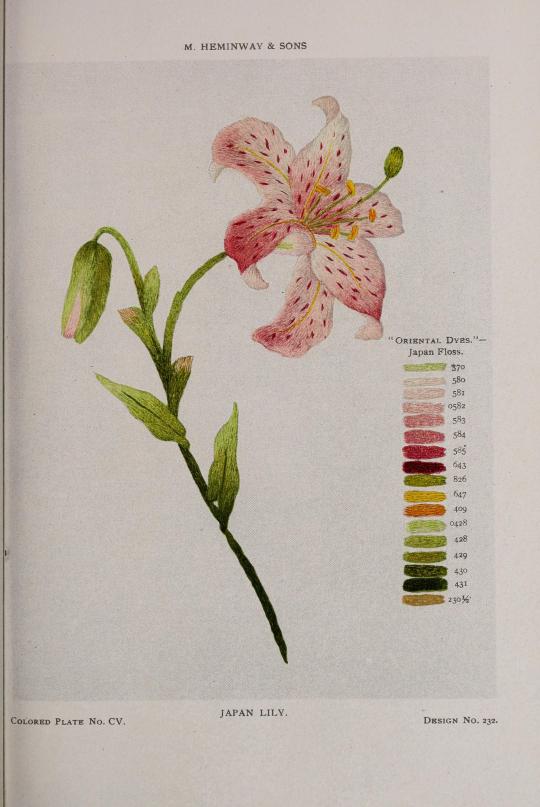
Please note, this book was written in 1899, and as such uses a racist term to refer to the dyes that were used for the thread. If you'd like to read more about this period in time, the term, and the stereotypes that the Victorians had, I've actually linked the wikipedia article here that goes more in depth. It's not the end all be all of it, but it's a good starting place for anyone wanting to educate themselves on the topic.
So the lily that is shown on this page, when I looked it up is called Lilium Speciosum. This lily is native to Southeast China, Japan, and Taiwan, and was introduced to English Gardeners in 1830. Trying to find the common names for it by the way has been a nightmare. In English it took me longer than it should have to find that it's called the Japanese Lily, Japanese show lily, or Rubrum Lily nowadays. Japanese Wikipedia when translated gives me Kanokoyuri, Doyou Lily, and Tanabata Lily as common names and much more information on the background than I can find on any of the English language websites I came across, so I've included a DeepL translated version of the Japanese Wikipedia page below. "Kanokoyuri (scientific name: Lilium speciosum) is a perennial herb in the lily family, Liliaceae. It is also known as the Doyou lily and the Tanabata lily. Characteristics:
The distribution is Kyushu (mainly from the Satsuma Peninsula to the coast of Nagasaki Prefecture), Shikoku (in the mountains of Ehime and Tokushima Prefectures), northern Taiwan, and Jiangxi Province, China, with the highest density of native plants in Japan in the Koshijima Islands. The grass is 1 to 1.5 m tall, and the flowering season is from July to September. The flowers, which are about 10 cm in length, are beautiful and have been cultivated for ornamental purposes since ancient times. The Japanese name is derived from the petals, which are spotted with a fawn pattern.
In the Edo period (1603-1867), Philipp Franz von Siebold brought bulbs of the canary lily out of Japan, and it is said to be the first Japanese lily to become known in Europe. During the Meiji period, the bulbs were boiled and dried and exported to China as a confectionery ingredient. In the Taisho era (1912-1926), bulbs were exported to the United States and used as fresh flowers for Christmas and Easter. In the postwar period, demand for lilies as ornamental flowers increased overseas, and during the period of rapid economic growth, breeding efforts were made to produce high-quality lilies, but from the 1970s onward, overseas demand declined.
Translated with DeepL.com (free version)"
I also translated the Chinese Wikipedia page, which gave me a common name of Deer Lily due to the spots. The translated Chinese Wikipedia Page via DeepL gives me a ton more information so I've also included it here: "also known as Lilium glaucum (Taiwanese: iām-hông lo̍k-á pik-ha̍p), Lilium beautifulum, Lilium medicum, Lilium glaucum, Lilium magenta, Lilium septuagenarianum, Lilium hyacinthum, and Lilium speciosum, is a species of lily in the family Liliaceae. It is a plant of the genus Lilium, with the species addition speciosum meaning "beautiful", and is found in Kyushu and Shikoku, Japan, Taiwan, and southern China, and is named for its flowers, which are covered with brilliant spots that resemble deer stripes. In Taiwan, there is a variety of red deer lily (Lilium speciousm var. gloriosoides) covered with reddish spots, which is endemic to Taiwan, and is also the curatorial flower of the National Museum of Natural Science in Taiwan, and is regarded as "the most beautiful lily in East Asia".
The bulbs are nourishing, strengthening, diuretic, cough suppressant, antipyretic and anti-inflammatory. In Japan, the flower language of the Kagoshima lily is "solemnity" and "compassion".
Growth:
It grows in the low altitude mountains of northern Taiwan, on rocky, exposed, sunny slopes." "Uses:
The bulbs are edible, rich in starch, and taste like potatoes. Deerberry lilies are so popular that there has been a lot of research into breeding them, and as a result there are cultivars of deerberry lilies in many gardens. People have crossed Deer Lily with Lily of the Valley to produce some valuable varieties, such as the "Imperial" series, and in 1964, the Japanese selected and bred the "Uchida" deep pink flower disease-resistant varieties from the Deer Lily. Problems" The red deer lily is currently endangered, with a small growing area, few breeding sites, and a decreasing number of growing areas and populations."
I've included the translations as is, but as we know, translation programs are dubious at best and unfortunately I lack the language skills to make sure that it translated properly. So if anyone who speaks Japanese, Chinese, or any of the other languages of the different areas this plant is native, can verify if the translation is accurate, tell me other common names of these lilies, and/or give me more information if possible, it would be much appreciated! Onward to the diagram description:
Flower. Description of accompanying Spray.
Pink: 1655 = Shade number 1, 404 = 2, 0405 = 3, 405 = 4, 406 = 5, 407 = 6.
Pistil & Stem:
432 = 7.
Pollen and Stamens:
647 = 8, 650 = 9.
Leaves and Stems.
Green: 0428 = Shade letter A, 428 = B, 429 = C, 430 = D.
Brown 230 1/2 = E, 230 3/4 = F.
A graceful stem with alternating leaves going up it has a single speckled lily branching off to the right and further up a larger bud is bowed over facing the left.
The stem starts with D and changes to C as it reaches the first leaf on the right side.
Leaf 1: Starting from the bottom of the leaf and going row by row upwards, E, D, D C, B, F.
Leaf 2 is slightly higher on the stem and roughly the same size, but this time is on the left side. Leaf 2: D, C, B, A.
Leaf 3 is a tiny leaf on the right side slightly higher up. Leaf 3: C, B.
The main stem is done in D, and changes to C higher up. The stem branches off to the right, and ends in the lily blossom. Stem Branch: C, B.
The lily has 6 petals that are randomly speckled. We will be starting with the petal closest to the stem, which is horizontal with the tip of the petal curling under to face right.
Petal 1 starting from tip and working our way back to the center in columns as the petal is horizontal, we will be going from the bottom up to the top in each column.:
Column 1: 3 (petal underside), 2 (petal topside), 3 (Petal Topside) Column 2: 4, 5. Column 3: 5. Column 4: 6.
Moving Clockwise to the next petals:
Petal 2, going by row now instead of columns, left to right:
Row 1: 2, 3. Row 2: 4 (petal underside), 4 (topside), 3 (topside) Row 3: 5, 4.
Petal 3:
Row 1: 1(underside). Row 2: 3. Row 3: 4. Row 4: 5. Row 5: 6.
Petal 4 is horizontal pointing to the right, row one is also going horizontal up the petal from left to right, starting from the top down. Petal 4: Row 1: 5, 4, 3. Row 2: 6, 3, 2.
Petal 5 is going in rows from center to tip: Row 1: 5, 4. Row 2: 5, 3.
Petal 6 emerges from under petal 5 and also goes in rows from center to tip:
Row 1: 4, 3. Row 2: 3. Row 3: 2, 3. Row 4: 2.
The stamens are done in 8 and 9 with the ones closer to the center of the flower being 9 and the ones further out being 8. The pistil and stems of the stamens are done in 7.
Moving on to the other fork on the original stem, we have a tiny leaf alternating left and one alternating right. The left leaf starts at C and ends in B at the tip. The right leaf starts at B and ends in A at the tip.
The stem continues up and then bows steeply to the left in a gradient from B to A. It ends in an oblong bud that starts in rows from top to bottom:
#historical embroidery#embroidery#embroidery pattern#victorian embroidery#historical sewing#sewing#needlework#needlecraft#fiber arts#fibre arts#fibre crafts#fiber art#fiber crafts
28 notes
·
View notes
Text
a link to a tutorial by Naomi Pankhurst on how to make a really nice hexagon mesh. This blog also has a lot of interesting tutorials, patterns, and other stuff in it that are worth checking out as well.
93 notes
·
View notes